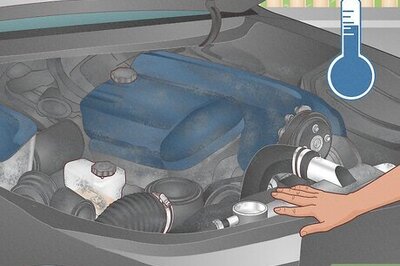
views
Begin by identifying the leaking radiator hose that needs to be replaced. Do this by running the car to operating temperature. Park the car on level ground with the engine running in park and emergency brake set. With the car running, visually inspect the hoses for collapse or leaks and do the same thing with the engine off.
Drain the engine coolant when it has cooled. Open the petcock on the lower end of the radiator and drain it into a bucket.
Loosen the clamps on the leaking radiator hose.
Grab hold of the hose and begin to work it off of the end it is attached to. Remove the hose clamps from the leaking radiator hose. If the hose will not slide off easily use a carpet knife to make a slice parallel to the hose from the hose end to just past the nipple it is attached to. Peel the hose from the nipple like an orange.
Push the hose firmly over the stub-out from the radiator and engine seating firmly over the rib that runs around the outer section of the stub-out as far as possible.
Slide the clamps down the hose to within the width of the clamp off the end of the hose and tighten as necessary.
Close petcock on the bottom of radiator and begin filling of radiator with the proper mixture and type of coolant.
Put the radiator cap back on and continue filling the system up at the coolant reservoir to cold level.
Start the engine and allow it to come to operating temperature.
Check for leaks watching the fluid level in the reservoir tank which should drop as the thermostat opens up.
Drive vehicle as you would normally and check coolant levels and recheck for leaks.
With the radiator cap off, allow to drain into a pan at least 2 gallon/3.8 liter in size.
When you turn the engine off the back pressure should reveal any leaks not seen. Top off the coolant as needed.
Slide the clamps onto the new hose.

















Comments
0 comment